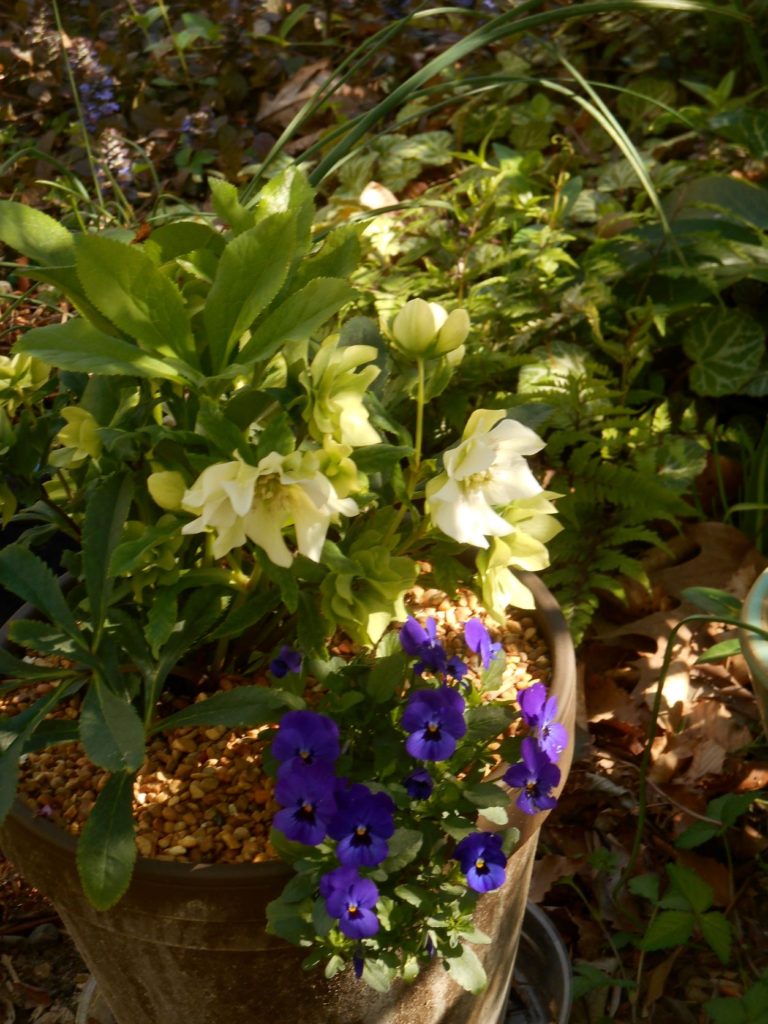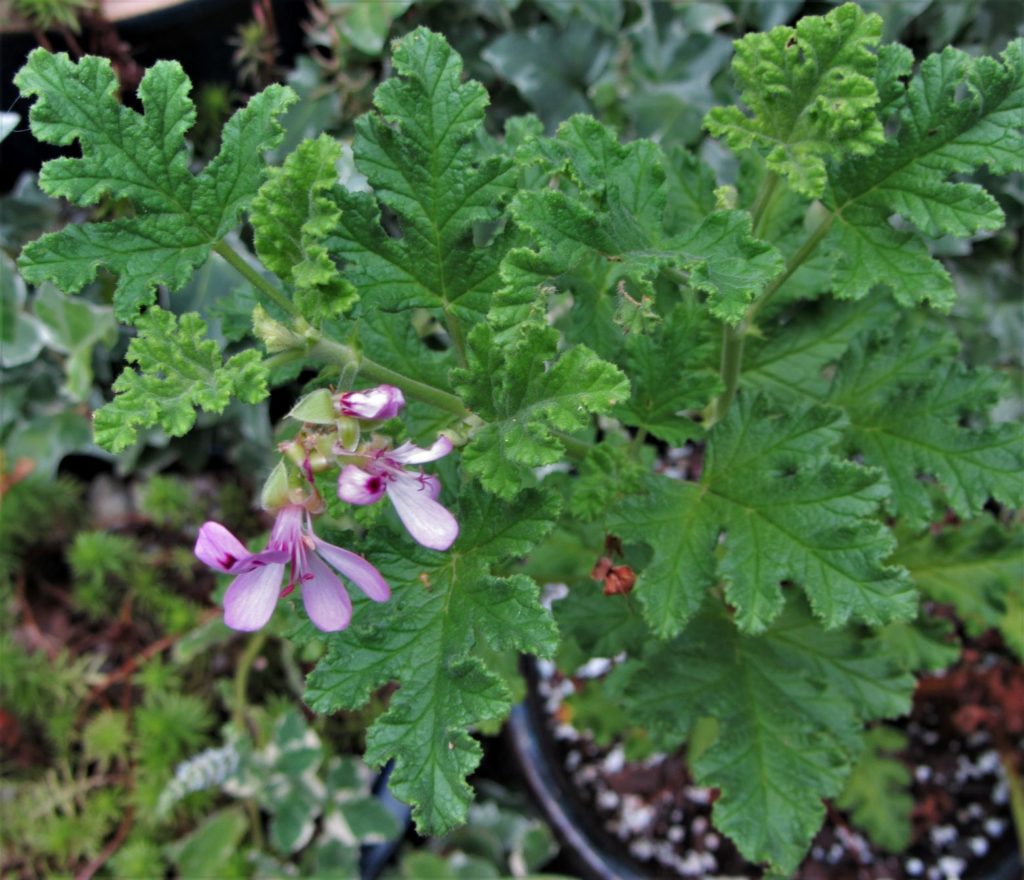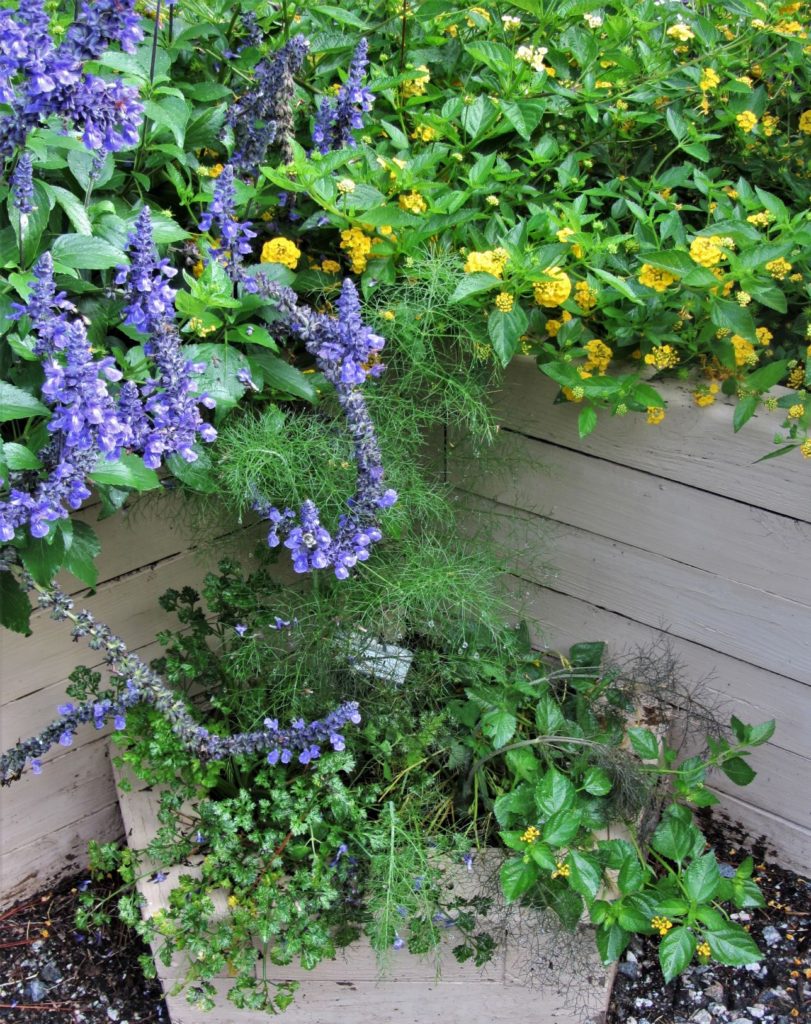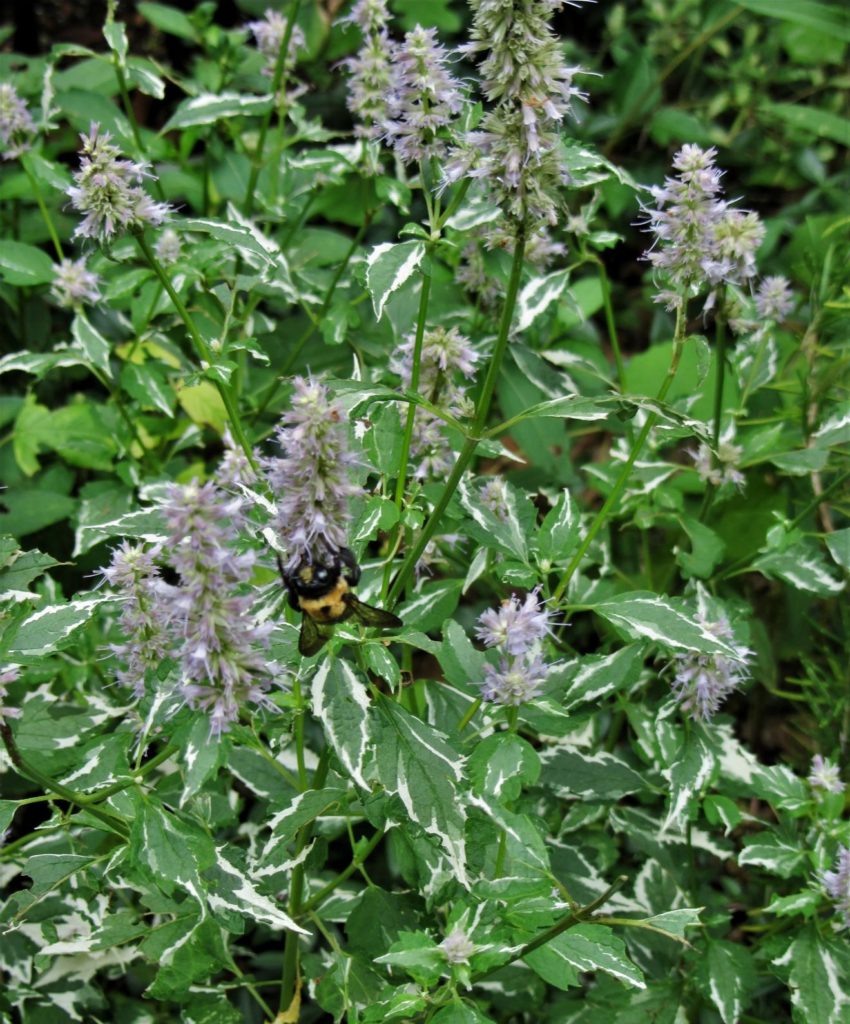Making Container Gardens for Wildlife
An older woman made her way slowly through the aisles of the garden center’s outdoor display area, leaning heavily on a cane. As I turned, hands loaded with small pots, she was behind me. She smiled and asked whether I had seen any bee balm on the display of herbs I’d been scanning.
We began to chat, and it turned out that she wanted to attract hummingbirds to the balcony of her apartment. Someone had told her that hummingbirds like bee balm.
Many of us enjoy not only the beauty of flowering plants in our pots, but we hope to see an occasional butterfly, bird, or hummingbird visiting our plantings. Watching these wild creatures feed brings us happiness and a measure of peace amid our busy lives.
There wasn’t any bee balm, Monarda, on the racks that day. I explained to her that while hummingbirds do like bee balm, it might not be her best choice. Bee balm needs regular cutting back to keep it blooming, and often develops mildew during our hot, humid summers. I suggested that she try Anise Hyssop, Agastache, or some Salvia, instead.
I led her to another part of the display area where native plants were offered and showed her several good cultivars of Agastache and Salvia that would bring her both hummingbirds and butterflies.
We plant a variety of flowering plants near our windows to attract butterflies, hummingbirds, native bees, and songbirds to feed. Even on the hottest summer afternoons, we can stand near the patio windows and watch hummingbirds flit from blossom to blossom. Butterflies float across the yard, resting on a hanging basket or pot for a few sips of nectar before moving on. Songbirds land on the pots, too, often looking for an insect to eat or pinching a bit of coco fiber from a basket liner. They forage for drupes among the Lantana and for seeds ripening on basil and on other flowering plants.

This pot features hybrid Salvia, Lantana montevidensis, Verbena x hyrida, Oxalis, Madegascar periwinkle and trailing Dichondra. These plants will help attract butterflies and hummingbirds to the patio of the Williamsburg Botanical Garden.
Since the flowers attract many small pollinating insects, a zipper spider weaves her web nearby, growing larger and larger each week as she feeds. Even small skinks and box turtles are attracted to the puddles left after watering, and an occasional toad will burrow into the cool damp soil of a low pot.
When we provide the sources of food, water and shelter wildlife need to live, whole communities of creatures show up, interact, and weave themselves into the ecosystem outside our windows.
When I visited a friend not long ago, she drew me over to a window looking out onto her deck. She had a potted Boston fern in a pot beside her lounge chair. And there, in the pot, was a small nest filled with baby birds, sheltered beneath the fronds of her fern. She could watch the baby birds as their parents fed them each day, and later, she watched them fledge.

Osmanthus ‘Goshiki’ grows well in a pot with snapdragons. Birds and other small animals find shelter in potted shrubs and large ferns.
Containers of the right plants attract a wide variety of wildlife to feed, drink, and maybe even find shelter on our porch, deck or balcony. We can live in harmony with them, if only for a short period of time.
To create wildlife sustaining container gardens, we need to choose the right containers, fill them with the right planting medium, site them in the right spots, select the right plants, and commit to care that will protect wildlife from hazardous chemicals. We should avoid using insecticides, fungicides and herbicides, which may kill the very animals we hope to attract. Even if we intend to target a ‘pest,’ these chemicals often have unintended consequences, especially once they enter the food chain.
When containers are placed on the ground, their weight usually isn’t a concern. But when we create planters for a porch, roof or balcony, we need to consider their finished weight, and where excess water will drain. If our sunny spot to garden is on an upper floor, we must consider those living below us.
We need to find a balance between containers large enough to accommodate the plants we hope to grow and light enough to sit on a porch or balcony safely. While we may select a beautiful, fired ceramic pot for a patio, we could consider a plastic, resin or polyethylene planter for a balcony.

Plastic containers weigh much less than ceramic. Fill the bottom few inches of deep containers with lightweight materials to further reduce their weight.
There are even lighter weight choices like growbags, storage bins, lined plastic baskets, lined hanging baskets, or vertical planters of various designs. We might also choose a shallow rectangular pot rather than a taller round one. It is the available surface area that often matters most. A 10”-12” deep container is sufficient for many plants.
While most plants require good drainage, it is often helpful to have saucers beneath the planters to catch excess water that drains after watering. Some pots have built-in reservoirs. Water collected after watering may attract small animals in search of a drink.
Normal garden soil is very heavy, especially when wet. Even compost weighs more than potting soil. Very large pots hold a lot of soil. Lighten it by choosing mixes that include coir, perlite, ground up bark, vermiculite, and other additives that also improve drainage. If a pot is very deep, you might fill the bottom few inches with ground bark or orchid potting mix, which is light, before filling it with a normal potting mix for containers.
While filling a new pot, consider adding a balanced, time-release powdered organic fertilizer to the mix to feed your plants’ growth. Espoma’s Bio-Tone is one choice which helps establish new growth and adds root nourishing fungi and other microbes to the new planting. This allows for the complex biochemical relationships between plants and soil so often missing when using a commercial, sterile potting mix. You might also add mushroom compost or earthworm castings to enrich the soil.

Hellebores and Violas bloom from late winter through spring. Aquarium gravel mulch protects the plants from splashing soil, keeping them healthier and cleaner.
Wire hanging baskets are usually lined with a coir liner. A plastic liner cut from a grocery or dry-cleaning bag, inside the fiber liner, helps conserve moisture in the planting mix. Poke a few holes with the tips of your scissors around the liner to allow for drainage. You might also cut a sponge into small 1” pieces and bury these in the planting mix to absorb water and release it to the roots as needed. After trimming the plastic, fold over the top inch and weight it with small stones or flattened glass marbles
After planting, mulch pots with a thin layer of aquarium or pea gravel. This promotes plant health by keeping the lower leaves and stems clean and helping them to dry more quickly after a rain. Many herbs, like lavender or rosemary will benefit from sunlight reflected off of the mulch and up into the plant. The mulch conserves soil moisture and presents a more decorative finish.
Orchid medium, shredded bark, or even living moss also serve as a good finish for containers. Alternatively, plant a creeping groundcover like Sedum or Ajuga under the larger plants.

Ivy geraniums, Verbena x hybrida and Euphorbia ‘Blush’ attract hummingbirds and butterflies to this basket. Use a plastic liner inside the coir to help hold moisture in the soil on hot summer days.
Most container gardens hold 3 to 9 plants. A larger pot needs less frequent watering and offers greater depth for roots to develop. A 20” pot is a good median size for planters. Anything smaller than 10” will need frequent attention and likely daily watering on hot days. Larger pots and baskets may also invite birds, and other small animals, to shelter or nest.
Pots and baskets require regular monitoring to keep the soil moist enough for the plants to grow well. Hanging baskets and small pots may need daily watering on hot days. Add time release fertilizer at planting, and use an organic liquid fertilizer such as fish emulsion in the water when you water a few times each month when plants are in active growth. Cutting back finished flowers and any faded leaves or stems keeps plants attractive and productive.
When pots are near your home, you would probably enjoy something growing in them year-round. In our Zone 7b climate, many plants will continue to grow and bloom through the winter months. Some plants can stay in place year-round, while others may be planted and then replaced as the seasons change.
Small evergreen shrubs, like Alberta Spruce, Osmanthus ‘Goshiki,’ or Camellia japonica, look nice year-round and can anchor an arrangement with other, blooming plants below. Even evergreens that don’t bloom can provide some shelter to wildlife and spots for them to perch and rest. If you plan a collection of pots, an evergreen shrub, fern or perennials can tie the arrangement together.
It is smart to use the limited space in a pot by planting in layers. Choose tall, medium and low plants to grow together, allowing some to cascade or vine over the side.
You can also plant in ‘temporal layers’ by including early spring bulbs that will fade away by early summer, along with hardy perennials that might not show growth until late spring or early summer. Roots, bulbs and rhizomes can live side by side in the soil, taking advantage of different seasons for their growth and dormancy. It is good to have something blooming to feed pollinators year-round in warmer climates, where native bees or other insects may fly in search of food on warmer winter days.
Install a simple trellis behind some pots to support vines, or you might place a support within the pot for vines to climb. Vines may be annuals or perennials, herbaceous or woody, depending on your preferences.
Containers allow us to try out many different plants and plant combinations. It is easy to pull out a plant we don’t like and slip another in its place. We can change the color scheme from season to season and year to year. Perennials may give us several years in their pot before we change them out.
Here is a short-list of some of my favorite wildlife friendly plants for container gardens. Some provide nectar, some are host plants, and some offer shelter. All of these plants grow well in containers, though the shrubs may eventually grow too large for the space and need root pruning or planting out in the yard.
Try a few new plants each year, along with your favorites. The joy of gardening is the joy of discovery. There is always more to learn and more to enjoy.
Favorite Wildlife Friendly Container Plants
Shrubs:
Alberta spruce, butterfly bush, Osmanthus, holly, Camellia, Oregon grape holly, Edgeworthia, Hibiscus syriacus

An Eastern Tiger Swallowtail nectars on butterfly bush, Buddleia davidii. Look for dwarf cultivars to grow in pots.
Perennials:
For sun:
Agastache, Salvia, Penstemon, scented Pelargonium, Ruellia, Rudbeckia, Dianthus, Verbena, Stachys byzantina, Echinacea, Sedum,
Hibiscus
For shade:
Hosta, Heuchera, Oxalis, Ajuga, hardy Begonia, Epimedium, Saxifraga stolonifera

Rose scented geraniums are marginally hardy in our area. Overwinter in a sheltered spot to keep the plant from year to year.
Herbs (Full to partial sun)
basil, thyme, lavender, rosemary, parsley, dill, fennel, mints, chives, garlic chives

Herbs, such as parsley, dill, and fennel serve as host plants for several swallowtail butterflies. They also bloom, providing nectar for many insects.
Annuals (sold as annuals in our climate)
For sun:
Lantana, Verbena, ivy geranium, Petunia, Angelina, Calibrachoa, Plectranthus, Salvia, Zinnia, Dahlia, Viola, Nasturtium, Ageratum
For shade:
Begonia, Coleus, Impatiens
Vegetables and fruits (all grow in full to partial sun)
Peas, pole beans, cherry tomato, bush cucumber, carrots, garlic, strawberry
Bulbs/geophytes
Crocus, Muscari, Narcissus, Canna, Crinum lily, Eucomis, Allium, Lycoris radiata or spider lily
Vines
Clematis, moon flowers, morning glory, Thumbergia alata, Mandevilla

Mandevilla attracts many pollinators, but is tender in our area. Overwinter it in a frost free area or treat it as an annual.
Ferns (These grow best in partial shade)
Japanese painted fern, maidenhair ferns, Japanese holly fern, ‘Brilliance’ autumn fern, Boston fern, Christmas fern

Japanese holly fern, Cyrtomium falcatum, remains evergreen all winter. Use it as an anchor plant to look good in containers year-round.
Moss (whatever grows locally on soil, used as living mulch in the pots.)
All photos by Elizabeth McCoy
Elizabeth McCoy is a JCCW Master Gardener Tree Steward









